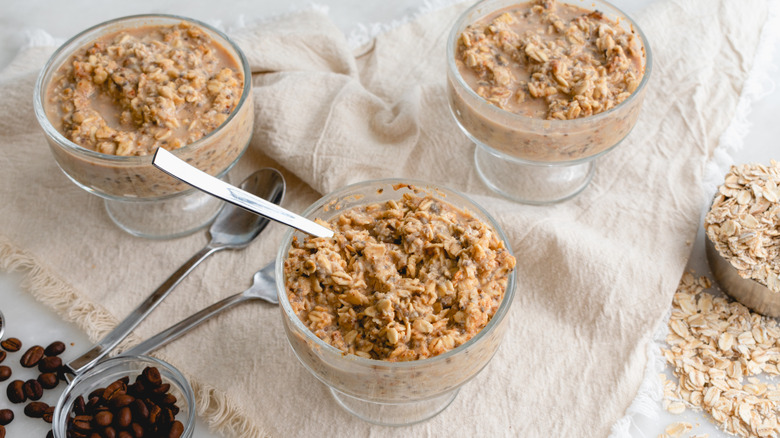One of the many qualities that make overnight oats a breakfast go-to is convenience. “Set and forget” is the motto for an AM grab-and-go meal, and overnight oats are an easy way to pack vital nutrients to kickstart your day. But, for maximum enjoyment, there’s more to overnight oats than just the flavorful additions to the mix. Texture is a huge name in the game, and there are key elements to consider to ensure that every bite of overnight oats has a delectable mouthfeel: not too dry, not too mushy, but just right. While combining all the ingredients and letting them meld with one another overnight might seem like a good idea, and what overnight oats are all about, you may want to think again. This seemingly handy hack might also be the culprit behind an unappetizing breakfast experience. While the prolonged soaking makes oats luscious and creamy, it can have an unwelcome effect on certain mix-ins.
Nuts, for example, lose their satisfying crunch, becoming unpleasantly chewy, and toppings like granola and toasted coconut flakes soften, losing their characteristic textural contrast to the creamy oats. On the other hand, fresh fruits like berries and peaches, which contain considerable moisture levels, can also dilute the final result when combined and left to sit overnight. The excess moisture results in an unappetizing soupy solution that would probably do the opposite of getting you charged for the day. On the contrary, nutritious ingredients like flax seeds and chia seeds benefit from soaking and afford a gelatinous texture that not only bulks up your oats with healthy fats but also doesn’t compromise the overall texture. Similarly, dried fruits like raisins and apricots will soak up the moisture, becoming plump and juicy, infusing natural sweetness into the overnight oats.
Tips for consistent textural perfection for your overnight oats
When it comes to an optimal oatmeal experience, a few fumbles can ruin the final result, from choosing the wrong type of oat to messing up the oat-to-liquid ratio. For overnight preparations, opt for rolled oats or steel-cut oats depending on your preference for a creamier texture, or one with more of a bite. Save instant oats for your microwave. Not only do the thinner flakes contain fewer nutrients and fiber due to extensive processing, but you’re likely to end up with an overly runny serving of oatmeal if used for overnight oats. To avoid overly dry or runny spoonfuls of oatmeal, it’s important to hone in on the best oats-to-liquid ratio that works best for you. Regardless of your choice of rolled or steel-cut oats, a good baseline is 2 parts liquid per 1 part oats. For extra creamy indulgence, incorporate your favorite milk variety or even silken tofu for added dairy-free protein.
The potential for a mix-in mishap doesn’t mean there’s no place for fresh fruit and crunchy additions to your overnight oats. Just make sure to save these mix-ins and toppings for the end, when ready to serve. That way, you get the creamy oatmeal base, complemented by the crunchy and juicy sources of extra nutrients.
Keep in mind that overnight oats can naturally settle, with denser components sinking and liquid sometimes separating, so give it a thorough stir to redistribute moisture and ensure a consistent texture throughout. Whether you prefer a serving of warm oats, infused with added flavors from a night in a slow cooker, or a cold, refreshing jar from the fridge, let these simple hacks allow you to achieve the perfect consistency of overnight oatmeal.






